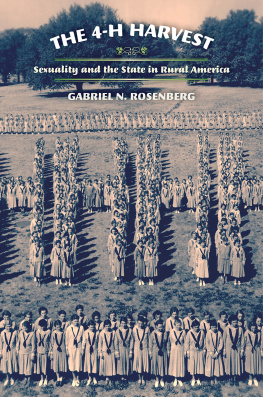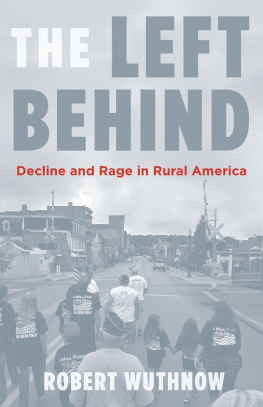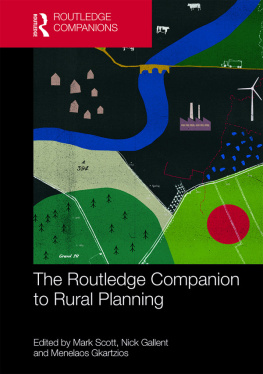Contents
Page List
Guide

The 4-H Harvest
POLITICS AND CULTURE IN MODERN AMERICA
Series editors:
Margot Canaday, Glenda Gilmore, Michael Kazin, Stephen Pitti, Thomas J. Sugrue
Volumes in the series narrate and analyze political and social change in the broadest dimensions from 1865 to the present, including ideas about the ways people have sought and wielded power in the public sphere and the language and institutions of politics at all levelslocal, national, and transnational. The series is motivated by a desire to reverse the fragmentation of modern U.S. history and to encourage synthetic perspectives on social movements and the state, on gender, race, and labor, and on intellectual history and popular culture.
The 4-H Harvest

Sexuality and the State in Rural America
Gabriel N. Rosenberg

UNIVERSITY OF PENNSYLVANIA PRESS
PHILADELPHIA
Copyright 2016 University of Pennsylvania Press
All rights reserved.
Except for brief quotations used for purposes of review or scholarly citation, none of this book may be reproduced in any form by any means without written permission from the publisher.
Published by
University of Pennsylvania Press
Philadelphia, Pennsylvania 19104-4112
www.upenn.edu/pennpress
Printed in the United States of America on acid-free paper
1 3 5 7 9 10 8 6 4 2
Library of Congress Cataloging-in-Publication Data
Rosenberg, Gabriel N., author.
The 4-H harvest : sexuality and the state in rural America / Gabriel N. Rosenberg.
pages cm. (Politics and culture in modern America)
Includes bibliographical references and index.
ISBN 978-0-8122-4753-4 (alk. paper)
1. 4-H clubsUnited StatesHistory. 2. United StatesRural conditionsHistory20th century. 3. Sociology, ruralUnited StatesHistory20th century. 4. AgricultureUnited StatesSocial aspectsHistory20th century. I. Title. II. Series: Politics and culture in modern America.
S533.F66R67 2016
For Ruth Farrell and Selma Rosenberg
CONTENTS

ABBREVIATIONS

AAA | Agricultural Adjustment Act of 1933 |
ABA | American Bankers Association |
ADT | Agribusiness Development Team |
AFBF | American Farm Bureau Federation |
AIA | American International Association |
ATP | Agricultural Training Program |
CCC | Civilian Conservation Corps |
CES | Cooperative Extension Service |
CORDS | Civil Operations and Revolutionary Development Support |
FTD | Foreign Training Division |
GVN | Government of the Republic of Vietnam |
IFYE | International Farm Youth Exchange |
IICA | Inter-American Institute of Agricultural Sciences |
LGCA | Land Grant College Association |
National Committee | National Committee on Boys and Girls Club Work |
PIJR | Programa Interamericano para la Juventud Rural |
SCS | Soil Conservation Service |
SDE | Southern Directors of Extension |
USAID | United States Agency for International Development |
USDA | United States Department of Agriculture |
USOM | United States Operations Mission to Vietnam |
VES | Vietnamese Extension Service |
WFA | War Food Administration |
INTRODUCTION

Signs of the State
Fretting about the countryside is a great American pastime. And contemporary anxieties about the state of rural America run as high as ever. Current worries range from industrial meat production and use of pesticides to depopulation and the scourge of methamphetamines, and they issue from across the political spectrum. Despite this anxious mood, politicians of all stripes and most voters are still deferential toward agrarian political rhetoric: the Jeffersonian ideal of the small, independent yeoman farmer and the belief that a virtuous rural past offers a model for a better future. In a time when increasing globalization pushes people to focus on local and small-scale action, the rhetoric of family farms is appealing. Yet that rhetoric sidesteps how, when, and why the current rural idyll came to such prominence. This book revises that political mythology by providing an overdue history to a key piece of agrarian Americana: 4-H, the homespun youth clubs that, over roughly a century of existence, taught millions of rural children how to be farmers and homemakers.
For my own part, rural places have rarely been a source of anxiety. Growing up in the Midwest, I was never a member of 4-H but was also never far from farms. Many of my most cherished experiences with the countryside, however, were linked to family vacations. Every summer, my parents hauled my siblings and me to a remote rented cabin near the western shore of Michigan for a week or two of swimming in frigid lake waters. We drove in the family minivan on U.S. 31 to a little town called Montague, cutting through endless fields of corn and soy on the way but missing any cities larger than South Bend. Travel with young children being what it was (and is), my parents made ample stops in the towns and businesses scattered along our route. We ogled an enormous stuffed steer in Kokomothe worlds largest!and paused for ice cream in Rochester. My mother still swears that we stopped at corn standssweet corn, boiled, dipped in butter, salted, and served hot enough to burn your fingersbut I dont remember that. I do recall the many fresh produce stands as we drew closer to our destination in the heart of Michigan fruit country. At those stands, my mother bought enough tart cherries to bake a half-dozen pies and pints and pints of blueberries that we promptly devoured. At the cottage, I split time between the beach and riding my bicycle on country back roads, where I lost myself in the late summer fields of wheat and corn and occasional orchards. My sense of what was beyond the city was formed in this delightful milieu of lush agricultural landscapes, scrumptious treats, frenzied excitement, and the asphalt lanes that stretched to the horizon, dotted occasionally with peculiar road signs emblazoned with four-leafed clovers.
Deciphering those signs tells us much about the complicated political culture that guides their placement. Across the country, rural communities welcome visitors with signs much like the one in Tillman County, Oklahoma: Tillman 4-H Club Welcomes You. The term 4-H and its emblematic clover appear ubiquitously in American popular culture as quiet totems of rural life. Many readers of this book will be familiar with 4-H. Some may have been part of the 70 million Americans who, in the past century, joined a 4-H club. Other readers may have had only a vague understanding of the organization. 4-H clubs are voluntary associations for youth between the ages of ten and twenty. Through most of 4-Hs history, the clubs were predominantly rural and focused on agriculture and home economics. 4-Hers, the term for club members, worked hard on a specific project through spring and summer, with the ambition of producing somethinga hog, a bushel of corn, a dress, a can of tomatoesto show at the county fair at the end of the growing season. And if they produced something of exceptional quality, they might even win a ribbon and the chance to compete at the state fair. 4-Hers, as both spectators and participants, are a ubiquitous presence at state fairs. Some may even be garbed in paraphernalia featuring the clover. Given the number of signs along county roads, 4-H and its clover stand not just narrowly for the club but for a broader sense of rural authenticity and pride, so much so that farm towns across America choose to express their civic identity in 4-Hs voice.









